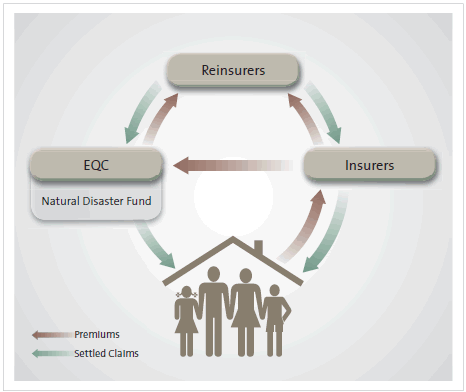Part 4: Insurance and the recovery
4.1
In this Part, we discuss:
- the effects of insurance complexity on owners of residential properties;
- the need to apportion damage to particular earthquakes;
- other complications;
- insurance premiums; and
- new insurance for public entities.
4.2
Insurance has a vital role in helping and funding the recovery.
4.3
The Canterbury earthquakes have created challenges for insurers and people with insurance claims. The Reserve Bank of New Zealand has reported that insurers' estimates indicate that the total cost of the earthquakes to insurance companies could be about $30 billion (although there is considerable uncertainty about this estimate).47 This estimate covers all insurance costs, not just those relating to the recovery.
4.4
Figure 7 shows how the insurance market works for property owners.
Figure 7
Insurers and the recovery

The effects of insurance complexity on owners of residential property
4.5
The volume and complexity of the work that is required to repair homes in Canterbury was not planned for and, although some properties have been repaired and the rebuilding of others is under way, there has been relatively little rebuilding. There are many reasons for this, including that:
- insurers and EQC are still deciding on the solutions and the eventual cost of repairs to some homes this is particularly so with TC3 properties (see Case Study 4 in Part 5);
- decisions about the extent of damage and the apportionment of damage to properties from the different earthquakes are complex and challenging deciding on when damage to a property was caused can affect whether a claim to EQC is above or below the $100,000 cap, and whether the property will be repaired by EQC or the insurance company;
- geotechnical assessments of land need to be completed to work out the best resolution for TC3 properties with damage to foundations; and
- ongoing seismic activity creates uncertainty.
4.6
Many householders are still working with EQC and their insurers to settle their claims. To date through its Managed Repairs Programme EQC has completed more than 21,000 repairs to the estimated 100,000 homes in the Programme.
Apportioning damage to particular earthquakes
4.7
EQC's cover of $100,000 for damage to individual buildings is reinstated after every earthquake. This means that, when settling a claim on a property, EQC assessors must assess the cost of damage to the property and identify which earthquake caused the damage. Some properties have suffered damage in each of the earthquakes, so EQC and private insurers must apportion the instances of damage to the property (and the cost) to particular earthquakes, up to the event that made the property uneconomic to repair.
4.8
EQC and private insurers must agree on the amount of damage caused by each earthquake.
4.9
Working out apportionment requires input from several data sources and is complex and time consuming. There have been disagreements between EQC and insurers about apportionment. The earthquakes have created circumstances not previously seen. As a result, EQC and private insurers have required and sought legal advice to clarify interpretations of the Earthquake Commission Act.
4.10
Reinsurers require the apportionment of damage and respective liabilities to be resolved before they will make payments to EQC or insurers. Reinsurance is a prudent risk management strategy used by insurance companies to minimise losses. EQC and private insurers buy reinsurance from the companies to limit their liability from a large-scale event. Reinsurance is provided by overseas companies. Like ordinary insurance, catastrophe reinsurance is only drawn on when claims are more than a certain value for an individual insurer. To receive this cover, insurance companies pay a premium to the reinsurers.
Other complications
4.11
Further complications arise when:
- the Government has not yet decided how to zone of land;
- there are delays in clarifying the liability that EQC has for land damage in TC3 areas;
- the flood management area has had to be redrawn because of land subsidence and estuary blockages;
- the risk of rock falls or cliff collapses has increased; and
- the technical design of some types of repairs is yet to be worked out.
4.12
In these situations, home owners cannot finalise their claims with EQC or their insurers. CERA has a role in liaising with insurers to monitor and encourage timely settlements of claims.48
4.13
By 25 June 2012, EQC had received 413,928 building claims and 92,873 land claims, and had paid a total of $3.175 billion.49
4.14
Part 5 includes case studies of properties that have suffered damage in the TC3 area and in the Port Hills area of Christchurch.
Insurance premiums
4.15
Insurance premiums have increased substantially since the Canterbury earthquakes. Insurers and reinsurers now see catastrophe insurance as posing higher risk because of many recent events worldwide, including the Canterbury earthquakes. The cost of reinsurance has risen sharply for insurers since the earthquakes and premiums for residential insurance have increased significantly.
New insurance for public entities
4.16
Insurance costs for many public entities have risen sharply since the earthquakes, and some public entities are struggling to insure their assets. In 2012/13, we will survey all public entities to understand how public entities are insuring their assets and at what cost.
47: Reserve Bank of New Zealand (May 2012), Financial Stability Report, page 31.
48: Canterbury Earthquake Recovery Authority (2011), Recovery Strategy for Greater Christchurch: Mahere Haumanutanga o Waitaha, page 19.
49: See the Earthquake Commission's Canterbury Earthquakes website, www.canterbury.eqc.govt.nz.
page top